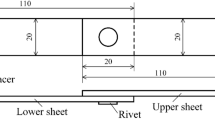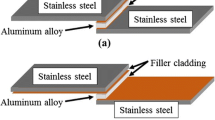Abstract
The fatigue tests of self-piercing riveted joints of AA5052 aluminium alloy were carried out by axial tension-tension loading mode. The microfracture characteristics of the specimen were analyzed by a scanning electron microscope. The fatigue property as well as the fretting damage failure mechanism of SPR joints with different parameters (distance, stress ratio, load level and riveting direction) were studied. The results show that the fatigue cracks occur in the fretting damage area where stress concentration exists. The form and the distribution of the fretting debris are important factors that affect the fatigue property of the joint. Within the value range, fatigue life increases with the increase of stress ratio, however, decreases with the increase of loading level adopted. The fatigue property of joints differs between different riveting directions. Better strength property could be obtained when the riveting direction reverses.
Access this chapter
Tax calculation will be finalised at checkout
Purchases are for personal use only
Similar content being viewed by others
References
Zheng H, Zhao XY (2016) Lightweight automobile and application of Aluminum alloys in modern automobile production. Forging Stamping Technol 41(2):1–6
Zhang Q, Ye PC, Yang ZY et al (2019) Application and development of connecting technique in automobile lightweight. Nonferrous Met Process 48(1):1–9
Wu XD, Wang M, Kong L et al (2016) Research status and application prospect of SPR self-riveting technology. Electric Weld Mach 46(4):31–36
Li DZ, Chrysanthou A, Patel I et al (2017) Self-piercing riveting-a review. Int J Adv Manuf Technol 92:1777–1824
Xing BY, He XC, Zeng K et al (2014) Mechanical properties of self-piercing riveted joints in Aluminum alloy 5052. Int J Adv Manuf Technol 75:351–361
Han L, Chrysanthou A, Young KW (2006) Mechanical behaviour of self-piercing riveted multi-layer joints under different specimen configurations. Mater Des 28(7):2024–2033
Liu Y, Zhuang WM, Shi HD (2019) Influencing factors on fatigue performance of self-piercing riveted joints: a review. Mater Rep 33(6):1825–1830
Li H, Bonnen J, Lasecki J et al (2016) Fatigue and fretting of mixed metal self-piercing riveted joint. Int J Fatigue 83:230–239
Han L, Chrysanthou A, O’Sullivan JM (2006) Fretting behaviour of self-piercing riveted aluminium alloy joints under different interfacial conditions. Mater Des 27(3):200–208
Huang ZC, Song TC, Lai JM (2019) Fatigue property and failure mechanism of self-piercing riveted joints of TA1 titanium alloy. Trans China Welding Inst 40(3):41–46
Huang ZC, Huang QW, Li SJ et al (2017) Influence of the self-piercing riveting position of dissimilar metal on fatigue strength. Forging Stamping Technol 42(9):150–156
Zhao L, He XC, Zhang XL et al (2017) Fretting wear and fatigue behavior of self-piercing riveting of lightweight alloys. Mater Rev 31(6):72–75
Moraes JFC, Rao HM, Jordon JB et al (2017) High cycle fatigue mechanisms of Aluminum self-piercing riveted joints. Fatigue Fracture Eng Mater Struct 1–14
Acknowledgments
This research is supported by the National Natural Science Foundation of China (51875201) and Key Research and Development Plan of Jiangxi Province (20192BBEL50013).
Author information
Authors and Affiliations
Corresponding author
Editor information
Editors and Affiliations
Rights and permissions
Copyright information
© 2021 The Minerals, Metals & Materials Society
About this paper
Cite this paper
Huang, Z., Zhang, Y., Lai, J. (2021). Fretting Damage and Fatigue Property Analysis of Self-piercing Riveted Joints of AA5052 Aluminium Alloy. In: Daehn, G., Cao, J., Kinsey, B., Tekkaya, E., Vivek, A., Yoshida, Y. (eds) Forming the Future. The Minerals, Metals & Materials Series. Springer, Cham. https://doi.org/10.1007/978-3-030-75381-8_119
Download citation
DOI: https://doi.org/10.1007/978-3-030-75381-8_119
Published:
Publisher Name: Springer, Cham
Print ISBN: 978-3-030-75380-1
Online ISBN: 978-3-030-75381-8
eBook Packages: Chemistry and Materials ScienceChemistry and Material Science (R0)




